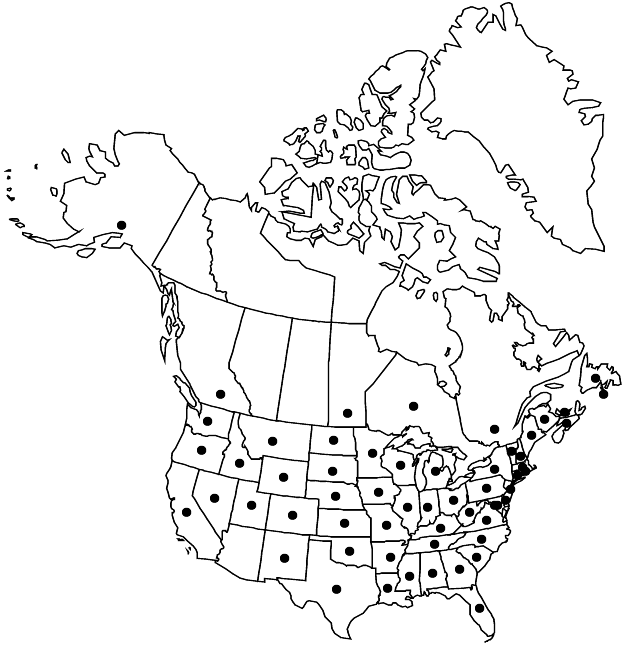Difference between revisions of "Persicaria hydropiper"
Hist. Nat. Vég. 10: 536. 1841.
FNA>Volume Importer |
FNA>Volume Importer |
||
| Line 30: | Line 30: | ||
|elevation=0-1500 m | |elevation=0-1500 m | ||
|distribution=St. Pierre and Miquelon;B.C.;Man.;N.B.;Nfld. and Labr. (Nfld.);N.S.;Ont.;P.E.I.;Que.;Ala.;Alaska;Ark.;Calif.;Colo.;Conn.;Del.;D.C.;Fla.;Ga.;Idaho;Ill.;Ind.;Iowa;Kans.;Ky.;La.;Maine;Md.;Mass.;Mich.;Minn.;Miss.;Mo.;Mont.;Nebr.;Nev.;N.H.;N.J.;N.Mex.;N.Y.;N.C.;N.Dak.;Ohio;Okla.;Oreg.;Pa.;R.I.;S.C.;S.Dak.;Tenn.;Tex.;Utah;Vt.;Va.;Wash.;W.Va.;Wis.;Wyo.;Europe;introduced also in Asia;nw Africa;Pacific Islands (Hawaii;New Zealand);Australia. | |distribution=St. Pierre and Miquelon;B.C.;Man.;N.B.;Nfld. and Labr. (Nfld.);N.S.;Ont.;P.E.I.;Que.;Ala.;Alaska;Ark.;Calif.;Colo.;Conn.;Del.;D.C.;Fla.;Ga.;Idaho;Ill.;Ind.;Iowa;Kans.;Ky.;La.;Maine;Md.;Mass.;Mich.;Minn.;Miss.;Mo.;Mont.;Nebr.;Nev.;N.H.;N.J.;N.Mex.;N.Y.;N.C.;N.Dak.;Ohio;Okla.;Oreg.;Pa.;R.I.;S.C.;S.Dak.;Tenn.;Tex.;Utah;Vt.;Va.;Wash.;W.Va.;Wis.;Wyo.;Europe;introduced also in Asia;nw Africa;Pacific Islands (Hawaii;New Zealand);Australia. | ||
| − | |discussion=<p>All parts of Persicaria hydropiper have an acrid, pepperlike taste. The plants have a long history of medicinal use in Europe, and the oily exudate produced in multicellular glands can cause skin irritation, hence the common name smartweed (R. S. Mitchell and J. K. Dean 1978). Some Native American tribes used P. hydropiper as a drug to treat a variety of ailments, and the Cherokee and Iroquois consumed it as food (D. E. Moerman 1998).</p><!-- | + | |discussion=<p>All parts of <i>Persicaria hydropiper</i> have an acrid, pepperlike taste. The plants have a long history of medicinal use in Europe, and the oily exudate produced in multicellular glands can cause skin irritation, hence the common name smartweed (R. S. Mitchell and J. K. Dean 1978). Some Native American tribes used <i>P. hydropiper</i> as a drug to treat a variety of ailments, and the Cherokee and Iroquois consumed it as food (D. E. Moerman 1998).</p><!-- |
| − | --><p>Herbarium specimens of Persicaria hydropiper often are misidentified as P. punctata. In addition to its minutely roughened and dull achenes, P. hydropiper differs from P. punctata frequently in bearing flowers enclosed in the ocreae, the inflorescences thus appearing somewhat leafy. By contrast, inflorescences of P. punctata generally appear terminal and leafless.</p> | + | --><p>Herbarium specimens of <i>Persicaria hydropiper</i> often are misidentified as <i>P. punctata</i>. In addition to its minutely roughened and dull achenes, <i>P. hydropiper</i> differs from <i>P. punctata</i> frequently in bearing flowers enclosed in the ocreae, the inflorescences thus appearing somewhat leafy. By contrast, inflorescences of <i>P. punctata</i> generally appear terminal and leafless.</p> |
|tables= | |tables= | ||
|references= | |references= | ||
| Line 56: | Line 56: | ||
|publication year=1841 | |publication year=1841 | ||
|special status= | |special status= | ||
| − | |source xml=https://jpend@bitbucket.org/aafc-mbb/fna-data-curation.git/src/ | + | |source xml=https://jpend@bitbucket.org/aafc-mbb/fna-data-curation.git/src/8f726806613d60c220dc4493de13607dd3150896/coarse_grained_fna_xml/V5/V5_1203.xml |
|subfamily=Polygonaceae subfam. Polygonoideae | |subfamily=Polygonaceae subfam. Polygonoideae | ||
|genus=Persicaria | |genus=Persicaria | ||
Revision as of 18:36, 18 September 2019
Plants annual, 2–8(–10) dm; roots also often arising from proximal nodes; rhizomes and stolons absent. Stems decumbent to ascending or erect, branched, without noticeable ribs, glabrous, glandular-punctate. Leaves: ocrea brown, cylindric or funnelform, (8–)10–15 mm, chartaceous, base inflated, margins truncate, ciliate with bristles 1–4 mm, surface glabrous or strigose, usually glandular-punctate; petiole 0.1–0.8 cm, glandular-punctate, leaves sometimes sessile; blade without dark triangular or lunate blotch adaxially, lanceolate to narrowly rhombic, (1.5–)4–10(–15) × 0.4–2.5 cm, base tapered or cuneate, margins antrorsely strigose, apex acute to acuminate, faces glabrous or scabrous along midveins, glandular-punctate, sometimes obscurely so adaxially. Inflorescences terminal and axillary, erect or nodding, interrupted or uninterrupted distally, 30–180 × 5–9 mm; peduncle (0–)10–50 mm, sometimes absent on axillary inflorescences and flowers thus enclosed in ocreae, glabrous, glandular-punctate; ocreolae not overlapping or overlapping distally, margins eciliate or ciliate with bristles to 1 mm. Pedicels ascending, 1–3 mm. Flowers 1–3(–5) per ocreate fascicle, homostylous; perianth greenish proximally, white or pink distally, glandular-punctate with punctae ± uniformly distributed, scarcely accrescent; tepals 4–5, connate ca. 1/3 their length, petaloid, obovate, 2–3.5 mm, veins prominent or not, not anchor-shaped, margins entire, apex obtuse to rounded; stamens 6–8, included; anthers pink or red, elliptic to ovate; styles 2–3, connate proximally. Achenes included or apex exserted, brownish black, biconvex or 3-gonous, 1.9–3 × 1.5–2 mm, dull, minutely roughened. 2n = 20.
Phenology: Flowering May–Nov.
Habitat: Shorelines of lake and ponds, banks of streams and rivers, fens, forested wetlands, pastures, occasionally waste ground
Elevation: 0-1500 m
Distribution

St. Pierre and Miquelon, B.C., Man., N.B., Nfld. and Labr. (Nfld.), N.S., Ont., P.E.I., Que., Ala., Alaska, Ark., Calif., Colo., Conn., Del., D.C., Fla., Ga., Idaho, Ill., Ind., Iowa, Kans., Ky., La., Maine, Md., Mass., Mich., Minn., Miss., Mo., Mont., Nebr., Nev., N.H., N.J., N.Mex., N.Y., N.C., N.Dak., Ohio, Okla., Oreg., Pa., R.I., S.C., S.Dak., Tenn., Tex., Utah, Vt., Va., Wash., W.Va., Wis., Wyo., Europe, introduced also in Asia, nw Africa, Pacific Islands (Hawaii, New Zealand), Australia.
Discussion
All parts of Persicaria hydropiper have an acrid, pepperlike taste. The plants have a long history of medicinal use in Europe, and the oily exudate produced in multicellular glands can cause skin irritation, hence the common name smartweed (R. S. Mitchell and J. K. Dean 1978). Some Native American tribes used P. hydropiper as a drug to treat a variety of ailments, and the Cherokee and Iroquois consumed it as food (D. E. Moerman 1998).
Herbarium specimens of Persicaria hydropiper often are misidentified as P. punctata. In addition to its minutely roughened and dull achenes, P. hydropiper differs from P. punctata frequently in bearing flowers enclosed in the ocreae, the inflorescences thus appearing somewhat leafy. By contrast, inflorescences of P. punctata generally appear terminal and leafless.
Selected References
None.